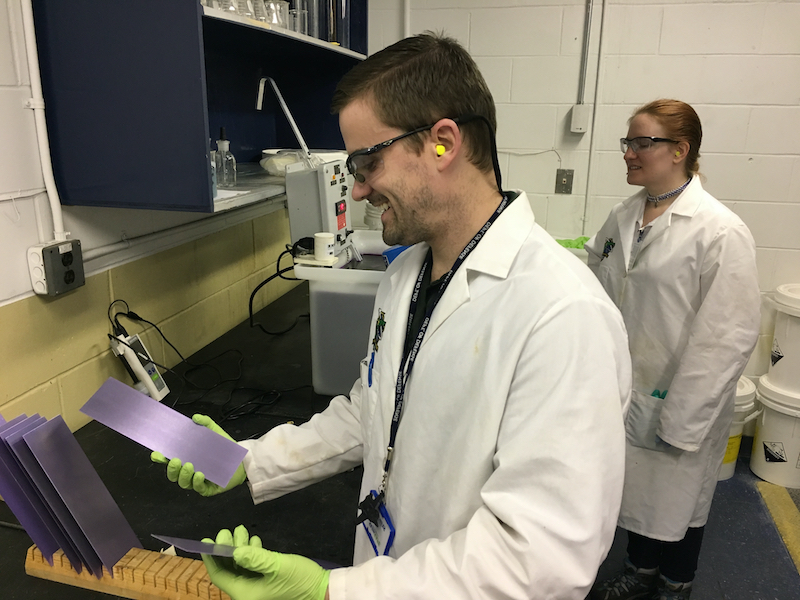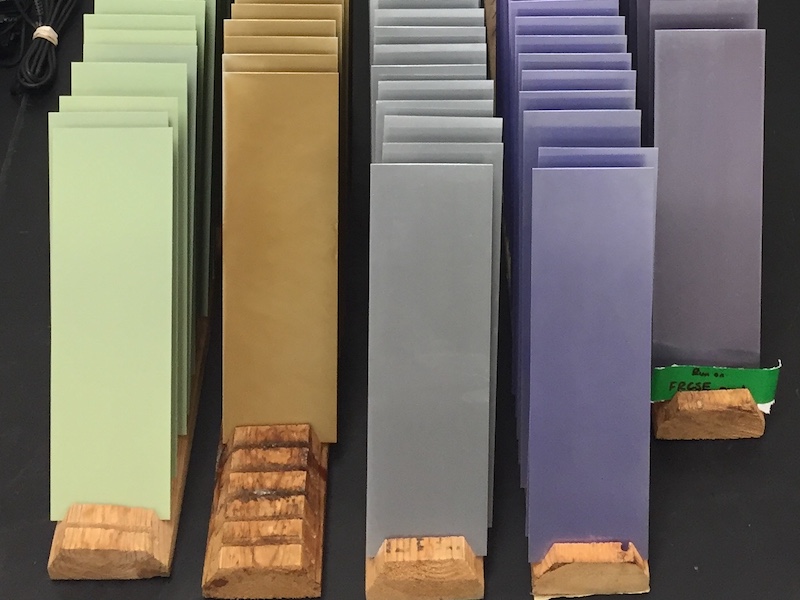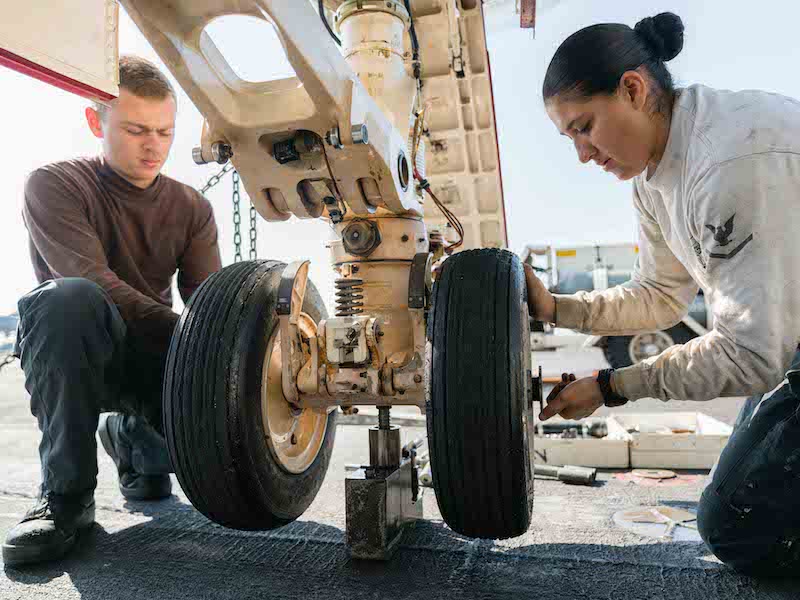For more than half a century, the finishing industry standard for conversion coating of aluminum aircraft components and surfaces was pretreatments that utilized hexavalent chromium. The result was an iridescent golden color change for ease of inspection, but the chromate was also a known carcinogen and environmental pollutant.
Chemical conversion coatings are adherent layers of low solubility oxide, chromate compounds produced on the surface of aluminum that converts the metal surface to a non-metallic inert state. These coatings are produced by a chemical oxidation-reduction reaction, with the main function to act as an undercoating and a base for organic finishes, as well as provide corrosion resistance and improve adhesion of paint finish systems on aluminum alloys
For decades, the industry searched for a “next generation” enhanced trivalent chromium pretreatment coating (eTCP) that was an environmentally safer alternative to hex chrome, and was also easy to inspect through color change. Several attempts came close to an alternative trivalent chromium undercoat that was safer, but they did not provide the obvious color change seen with hexavalent chromium, which could lead to difficulty identifying the presence of coatings for quality control purposes.
 But that all changed when CHEMEON Surface Technology in Minden, Nevada, began working with the Naval Air Systems Command (NAVAIR) and the Fleet Readiness Center Southeast (FRCSE) several years ago on a NextGen research project that resulted in CHEMEON eTCP, the first trivalent conversion coating and anodic seal with distinct color — from silver to blue or purple — for visual verification that parts are coated and protected. In addition, CHEMEON eTCP has excellent corrosion resistance, low electrical resistance and superior paint adhesion.
But that all changed when CHEMEON Surface Technology in Minden, Nevada, began working with the Naval Air Systems Command (NAVAIR) and the Fleet Readiness Center Southeast (FRCSE) several years ago on a NextGen research project that resulted in CHEMEON eTCP, the first trivalent conversion coating and anodic seal with distinct color — from silver to blue or purple — for visual verification that parts are coated and protected. In addition, CHEMEON eTCP has excellent corrosion resistance, low electrical resistance and superior paint adhesion.
“It was an intense challenge for everyone involved, almost like cracking a code,” says Ted Ventresca, president and chief operating officer of CHEMEON. “For decades, this formulation was something that seemed beyond reach. But it truly was about bringing the best and brightest minds together to pull it off for the next generation of conversion coatings for the aerospace industry.”
The path to CHEMEON eTCP has been a long and arduous task, but the payoff is dramatic for aerospace and naval coatings. In legacy coating processes that were the standard for decades, conversion coatings were the undercoat and base for primer paints that went over the aluminum alloy substrate. That often followed with a hexavalent chromium primer, and then a topcoat that were evident by an iridescent, golden finish that was reflective of the chromate materials.
CHEMEON’s researchers brought their extensive knowledge and research capabilities with NAVAIR and FRCSE through a Cooperative Research and Development Agreement (CRADA), which provides for joint research and development, and a sharing of facilities, knowledge, experience and intellectual property. The potential Navy benefit was huge:
- Reduced hexavalent chromium usage.
- Elimination of hexavalent chromium reduction requirements for conversion coat rinse water.
- Reduced occupational exposure to hexavalent chromium.
- Reduced risk of hexavalent chromium migration to adjacent work centers.
“The goal was a development of an enhanced trivalent chromium pretreatment (eTCP) that included the addition of dye to the chemistry that reduced implementation barriers,” says Dr. Sjon Westre, vice president of technology at CHEMEON. “The benefits to the Navy are that it lowers potential for quality escapes through visual verification of proper coating application, which decreases turnaround time through elimination of rework due to improper coating application.”
 Dr. Westre also says development of an eTCP contributes to the goal of the Environmental Security Technology Certification Program (ESTCP) hexavalent chromium migration reduction goal of 90%, as well as eliminates chemical of concern for AIR-1.6 acquisition/sustainment.
Dr. Westre also says development of an eTCP contributes to the goal of the Environmental Security Technology Certification Program (ESTCP) hexavalent chromium migration reduction goal of 90%, as well as eliminates chemical of concern for AIR-1.6 acquisition/sustainment.
Peter Sheridan, a senior materials engineer with the NAVAIR and FRCSE, says they evaluated several TCP manufacturers and processed more than 200 test specimens before deciding to work with CHEMEON on the project.
“For our organization, the end goal is to achieve a smooth transition away from hexavalent chromium conversion coatings and eTCP provides an avenue for that,” says Sheridan, whose group chose CHEMEON’s TCP-HF in 2015 to further develop during the research because of its unique trivalent chromium based conversion coating chemistry, what was specifically formulated and developed for aluminum, magnesium, zinc alloys, anodized aluminum and platings.
The hex-free CHEMEON TCP-HF was a proven commodity, having surpassed over 15,000 test panels and outperforming existing trivalent and hexavalent alternatives in wear and corrosion resistance, and without requiring additional topcoats. Plus, it was more economical in cost per application.
The NextGen goal amongst the NAVAIR and FRCSE staff working with CHEMEON’s top researchers was to find one that performed as well as the company’s TCP-HF, but also provide the dye enhancement.
“There is a substantial quality control problem if you can’t tell the coating has been applied,” says Dr. Westre. “In the past, we’ve relied on training and spot tests to answer that concern, but the lack of color has been a large barrier to implementation.”
Starting in 2016, the research teams at CHEMEON, NAVAIR and FRCSE researched and tested the processes to validate results, mitigates risks of processing volume and coating uniformity, and selected a final range of concentrations to evaluate. Over the next three years, the researchers processed test panels testing for corrosion resistance, paint adhesion and color change, while documenting results in numerous interim reports that brought some excitement to the finishing industry.
In 2018, several breakthroughs by the CHEMEON research staff began to take hold. New formulation of eTCP began to develop with two colors: blue and violet. The eTCP-Blue salt fog tests on AA2024 surfaces resulted in over 1,300 hours of protection; the eTCP-Violet came in at more than 1,000 hours of salt fog on AA2024.
Also in 2018, testing at FRCSE saw a 10 gallon pilot line with eTCP-Violet to generate salt fog panels and beach exposure testing of primed panels with MIL-PRF-85582 waterborne primer, Type I, Class C1, After four months of exposure, there was no damage or corrosion to the panels. The results were very promising and exciting for the research teams:
- Average before salt spray for eTCP-Blue was 522.5 ± 3.5 µΩ/in2
- Average before salt spray for eTCP-Violet was 525.0 ± 2.1 µΩ/in2
- MIL-DTL-5541F and MIL-DTL-81706B specify <5,000 µΩ/in2, which were two orders of magnitude below specification limit
The end result was the NextGen pretreatment CHEMEON eTCP in blue and violet dyes that exceeds MIL-DTL-5541 and MIL-DTL-8170 requirements for corrosion protection, electrical resistance and adhesion, and beta testing has had some noteworthy results.
“Our invention solved the problem of creating a color, while still providing very good performance,” says Westre. “The corrosion protection of eTCP is quite a bit better than the TCP coatings.”
Application options include room-temperature immersion/dipping, spray, brush and pen. CHEMEON eTCP RTU is a robust colorized “ready to use” trivalent chromium chemical conversion coating for aluminum alloys, magnesium, and zinc alloys, as well as a sealer for anodized aluminum. CHEMEON eTCP Touch-Up Pen utilizes the same chemistry and is optimized for touch-up and field repair use while packaged in a 1.5 oz/60mL pen applicator.
“When you consider how and where touchup pens are used,” says Westre, “the TCP and eTCP touchup pens are a tremendous improvement in worker safety.”
The NextGen project to solve the eTPC issue was one that CHEMEON hopes to build on in future products it brings to the finishing market to further assist facilities with aerospace coating projects. Other aerospace applications include:
- Spray application to aircraft.
- Post treatment for cadmium, zinc nickel and Class 1 IVD aluminum.
- Conversion coating on other light metals such as magnesium and zinc.
- Steel galvanize quench.
“CHEMEON eTCP represents the evolution of trivalent chromium pretreatments, and it’s a fantastic product that we are very proud to bring to the finishing market,” says Dr. Madylon Meiling, the company’s chief executive officer. “One look and you know that your parts are protected.”
If you would like further information, please visit CHEMEON.com, email at info@chemeon.com, or call 888-782-8324.



































